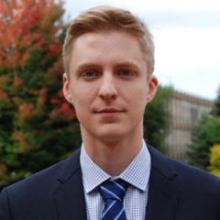By Jack Simonson, CFRM MS Graduate
When I started the Computational Finance and Risk Management (CFRM) program I truly had little-to-no idea of what I would wind up doing once I graduated. I had vague notions of what I might do and areas of study that interested me, but what company or job description I wanted to wind up with was still a mystery. I imagine that I wasn’t the only one who felt this way when entering the program, but hopefully what I can say here will help assuage some of that anxiety and doubt that new students might have.
For me, the most important element of the CFRM program was the backgrounds of the professors. They all brought a variety of professional and academic experience which they were able to parlay into their teaching. We were provided with exceptional resources and ample opportunities to listen to lectures from industry professionals, former professors in the program, visiting academics, current graduate students, and others to help inform us about life outside of the program, whether that be as a professional in the mathematical finance field or as a future academic. The faculty provided us with the tools we needed to help shape our direction and decisions about what we might want to do with our higher education. Shortly into the program I had begun to form ideas of what I wanted to do with my education and I was able to approach Tim Leung, Director of CFRM, about doing research in a field that had piqued my interest.
You may know from the 2017 newsletter that Tim’s research has focused on modeling and examining the behavior of exchange traded funds (ETFs), leveraged ETFs, and mean-reversion trading of these financial instruments. Despite stochastic calculus being novel to me upon entering the program I found the work he was doing fascinating. I was able to assist him in supervising a project titled “Mathematics of Exchange-Traded Funds" in the Washington Experimental Mathematics Lab. This experience led to my decision to embark upon extending some Tim’s of research into examining the behavior and performance of high-frequency trading of ETF pairs. While doing research with Tim and taking courses on electronic/automated trading I realized that perhaps I had the ability to do this in real life or pursue it further in a PhD program.
As I was finishing up this research and close to graduating I decided to jump at the chance to work for FEV Analytics, a small data science firm in Kirkland. We specialize in statistical modeling and analysis of private equity and alternative asset investments, an entirely new field for me. Unlike publicly traded assets, private equity is extremely opaque; comprehensive data, financial information, and other fundamentals needed to understand asset movement are hard to find and even harder to obtain access to. Historically, the industry has strongly relied on person-to-person relationships between limited partners (LPs; the large endowments/pension funds/institutional investors that have a stake in a given fund) and general partners (GPs; the fund managers who call on equity commitments made by LPs invested in their fund). GPs typically give financial summaries and investment analyses at the end of each quarter, but these reports are often lagged by weeks or months so that by the time an LP gets information on the value of their investments at the end of a given quarter they’re already halfway towards the end of the next financial quarter. As you can imagine this makes it difficult for LPs to understand their investments at any given time. Proper risk management, liquidity analysis, and other dimensions of understanding of one’s investments are difficult to perform with lagged data that comes from a source that has a slight bias (this isn’t to say that GPs manipulate the value of their investments but their survival depends on high internal rates of return; obscure measurements in an opaque market where the GP controls the inputs naturally lends itself to skepticism). My current job is to apply statistical modeling techniques that I learned at UW in order to better understand and predict how investments on both the fund and asset level will move using objective measurements and tools. We are able to use out methodology to model asset movement in (nearly) continuous time, providing investors with the ability to conduct risk analysis and liquidity evaluation on an at-will basis (a more in-depth analysis can be found on SSRN).
While almost no part of my current job relates to high-frequency trading or modeling ETF movements, I realize that what I learned at UW has been invaluable in my current role. I know people who have wound up working for companies in a variety of fields, from tourism to arbitrage trading to tech. These are diverse fields and yet the skills we learned have allowed us to succeed no matter what industry we wind up in. Almost all of our roles involve statistical analysis and some programming, but the application of these skills is diverse, and the possibilities are limitless. For those new students in the CFRM program who share some of the anxiety that I felt at the beginning I urge you to absorb as much as you can from your professors and the opportunities afforded to you in order to see how your education might translate into future employment. You might surprise yourself with what you find interesting and where you end up professionally. And who knows, I might still seek to continue my research on the PhD level and I encourage current and future students to consider that possibility too. No matter what direction you want to take your education, you’ll find the right tools to help you at UW.
